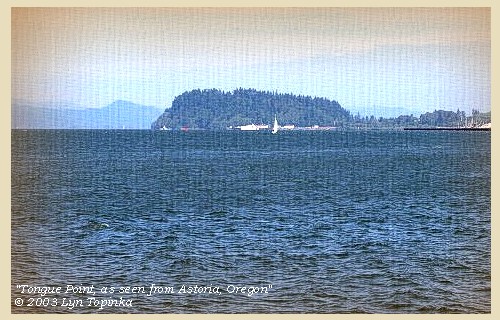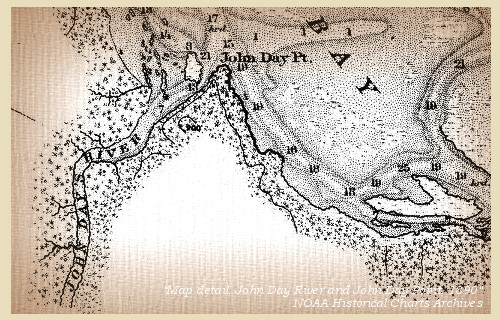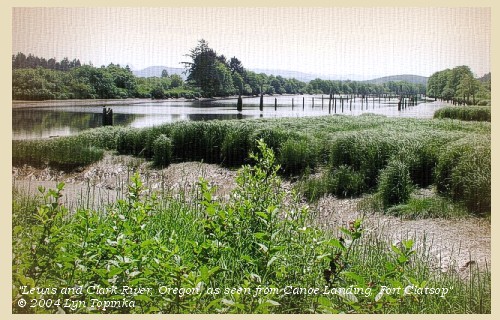The Volcanoes of
Lewis and Clark
Lewis and Clark
|
December 1 - 6, 1805 Looking for a Place to Winter - At Tongue Point |
|
Home
The Volcanoes of Lewis and Clark Map of the Journey Volcanoes, Basalt Plateaus, Major Rivers, etc. The Volcanoes Mount Adams, Mount Hood, Mount Jefferson, Mount Rainier, and Mount St. Helens CALENDAR of the Journey October 1805 to June 1806 Along the Journey Pacific Northwest Maps - Columbia River, Volcanoes, Flood Basalts, Missoula Floods, Geology, etc. The Corps of Discovery The Journey of Lewis and Clark About the Reference Materials The Journals, Biddle/Allen, DeVoto, Gass, Moulton, Topo Maps, and others USGS Lewis and Clark Links Links to USGS Websites highlighting the Lewis and Clark Journey Resources Publications Referenced and Websites Visited |
PREVIOUS
November 26 Looking for a Place to Winter, Pillar Rock to Tongue Point |
December 1-6
Looking for a Place to Winter, At Tongue Point Tongue Point, John Day River (Clatsop County), Lewis and Clark River |
CONTINUE
December 7-25 A Place to Winter, Tongue Point to Fort Clatsop |
|
At the Pacific - December 1805
Looking for a Place to Winter - At Tongue Point |
| Lewis and Clark's camp from November 27, 1805 to December 6, 1805, was on the west side of the isthmus at Tongue Point, just east of present-day Astoria, Oregon. The majority of the party under Captain Clark remained here until December 7, 1805, while Captain Lewis and five men scouted for a suitable winter camp. |
| Sunday, December 1, 1805 |
| Again we had a cloudy day, and the wind so high from the east, that having ventured in a boat with a view to hunt at some distance, we were obliged to return [their camp on the west side of the isthmus of Tongue Point]. |
| We resumed our occupation of dressing leather and mending our old clothes, in which we passed the day. The hunters came in with a report of their having seen two herds of elk, but they could kill nothing, and we therefore again fed upon dried fish. At sunset it began to rain violently, and continued all night ...... |
|
|
|
The Camp - November 27 through December 6, 1805
On the west side of Tongue Point, just east of present-day Astoria, Oregon. The majority of the party under Captain Clark remained here until December 7, 1805, while Captain Lewis and five men scouted for a suitable winter camp. |
| Monday, December 2, 1805 |
| This disagreeable food, pounded fish, has occasioned so much sickness among the men that it is now absolutely necessary to vary it. Three hunters therefore set out, and three more were sent up the Kekemahke creek [John Day River, Clatsop County, Oregon] in search of fish or birds. |
| Towards evening one of them returned: he had observed great appearances of elk, and even seen two herds of them; but it rained so hard that he could with difficulty get a shot: he had, however, at last killed one, at the distance of six miles from the camp, and a canoe was now sent to bring it. The party from Kekemahke creek [John Day River, Clatsop County, Oregon] were less successful: they had seen no fish, and all the birds, in consequence probably of being much hunted by the Indians, were too shy to be approached. |
|
|
|
The Camp - November 27 through December 6, 1805
On the west side of Tongue Point, just east of present-day Astoria, Oregon. The majority of the party under Captain Clark remained here until December 7, 1805, while Captain Lewis and five men scouted for a suitable winter camp. |
| Tuesday, December 3, 1805 |
| The wind was from the east, and the morning fair; but, as if a whole day of fine weather was not permitted, towards night it began to rain. Even this transient glimpse of sunshine revived the spirits of the party, who were still more pleased, when the elk killed yesterday was brought into camp. This was the first elk we had killed on the west side of the Rocky mountains, and condemned as we have been to the dried fish, forms a most nourishing food. After eating the marrow of the shank-bones, the squaw chopped them fine, and by boiling, extracted a pint of grease, superior to the tallow itself of the animal. A canoe of eight Indians, who were carrying down wappatoo roots to trade with the Clatsops, stopped at our camp: we bought a few roots for small fish-hooks, and they then left us: but accustomed as we are to the sight, we could not but view with admiration the wonderful dexterity with which they guide their canoes over the most boisterous seas; for though the waves were so high, that before they had gone half a mile the canoe was several times out of sight, they proceeded with the greatest calmness and security. Two of the hunters who set out yesterday had lost their way, and did not return till this evening: they had seen in their ramble great signs of elk, and had killed six elk, which they had butchered and left at a great distance. A party was sent in the morning, |
|
|
|
The Camp - November 27 through December 6, 1805
On the west side of Tongue Point, just east of present-day Astoria, Oregon. The majority of the party under Captain Clark remained here until December 7, 1805, while Captain Lewis and five men scouted for a suitable winter camp. |
| Wednesday, December 4, 1805 |
| to carry the elk to a bay, some distance below, to which place, if the weather permitted, we would all remove our camp this evening; but the rain which had continued during the night lasted all next day, and was accompanied by so high a wind from the southeast and south, that we dared not risk our canoes on the water. It was high water at eleven o'clock, when the spring-tide rose two feet higher than the common flood-tides. We passed the day around our fires, and as we are so situated that the smoke will not immediately leave the camp, we are very much incommoded, and our eyes injured by it. No news has yet been received from captain Lewis, and we begin to have much uneasiness for his safety. |
|
|
|
The Camp - November 27 through December 6, 1805
On the west side of Tongue Point, just east of present-day Astoria, Oregon. The majority of the party under Captain Clark remained here until December 7, 1805, while Captain Lewis and five men scouted for a suitable winter camp. |
| Thursday, December 5, 1805 |
| It rained during the whole night, and this morning the rain and high wind compelled us to remain at our camp. Besides the inconvenience of being thus stopped on our route, we now found that all our stores and bedding are again wet with rain. The high water was at twelve o'clock, and rose two inches beyond that of yesterday. In the afternoon we were rejoiced at the return of captain Lewis, who came in a canoe with three of his men, the other two being left to guard six elk and five deer which they had killed: he had examined the coast, and found a river a short distance below [Lewis and Clark River], on which we might encamp during the winter, with a sufficiency of elk for our subsistence within reach. |
| This information was very satisfactory, and we decided on going thither as soon as we could move from the point [Tongue Point]; but all night and the following day, |
|
|
|
The Camp - November 27 through December 6, 1805
On the west side of Tongue Point, just east of present-day Astoria, Oregon. The majority of the party under Captain Clark remained here until December 7, 1805, while Captain Lewis and five men scouted for a suitable winter camp. |
| Friday, December 6, 1805 |
| it rained, and the wind blew hard from the southwest, so that the sea was still too rough for us to proceed. The high-tide of to-day rose thirteen inches higher than it did yesterday, and obliged us to move our camp to a high situation. Here we remained waiting for better weather, till about dark the wind shifted to the north, and the sky was clear. We had now some prospect of being able to leave our situation, and indeed although some rain fell in the course of the night, the next morning, |
|
|
|
The Camp - November 27 through December 6, 1805
On the west side of Tongue Point, just east of present-day Astoria, Oregon. The majority of the party under Captain Clark remained here until December 7, 1805, while Captain Lewis and five men scouted for a suitable winter camp. |
| Home | Previous | Continue |
If you have questions or comments please contact: GS-CVO-WEB@usgs.gov
June/July 2004, Lyn Topinka
The Volcanoes of Lewis and Clark Home Page | CVO Home Page


















